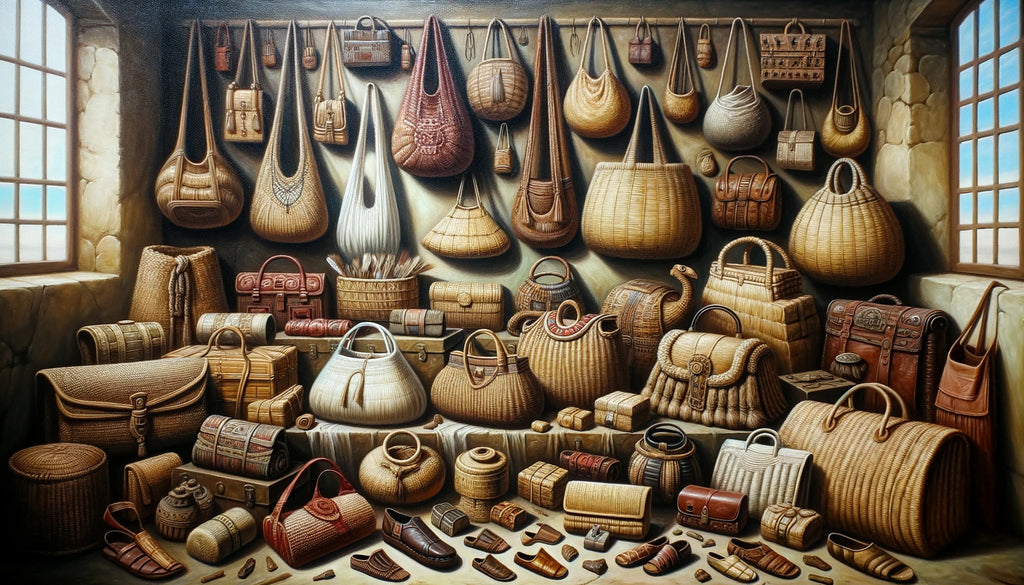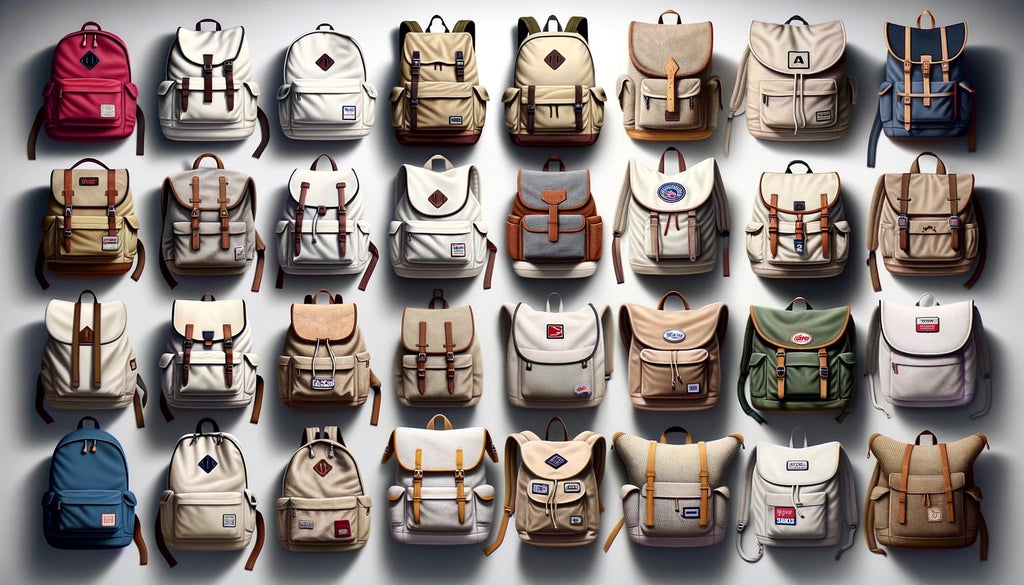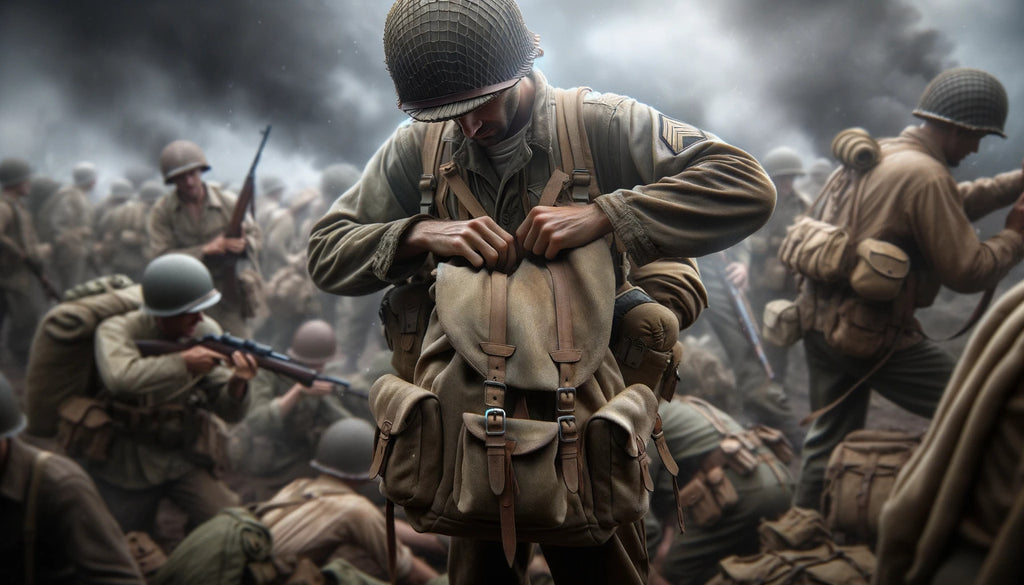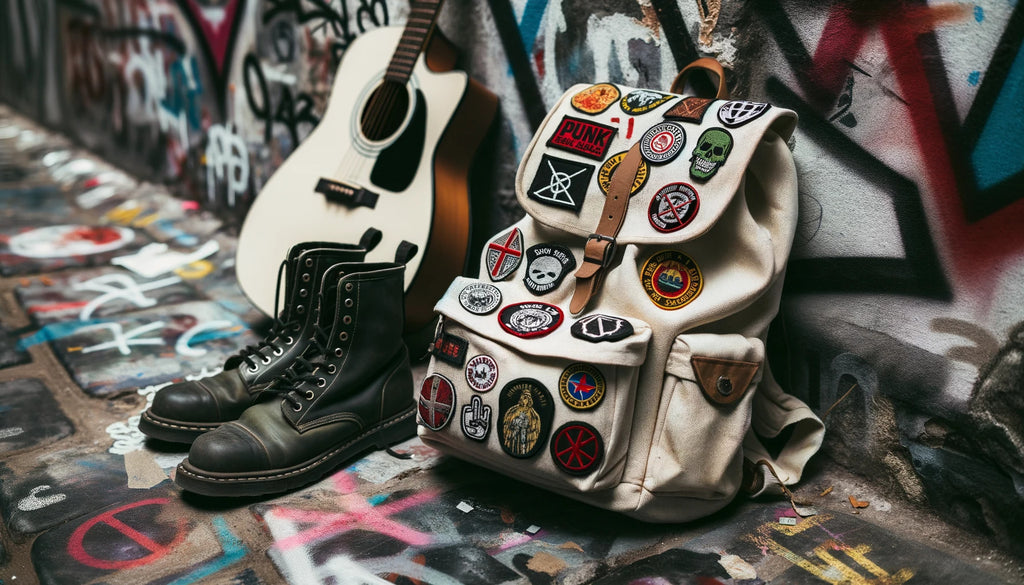
History of Canvas Backpacks - From Ancient Civilizations to Modern Streets
Reading Time: about
In the vast tapestry of human history, few items have woven their way into our daily lives quite like the canvas backpack.
From ancient civilizations to modern urban jungles, the canvas backpack has journeyed with us, evolving in design, utility, and cultural significance.
Dive into this captivating tale of adaptability, innovation, and style, and discover how a simple carrying tool became an iconic fashion statement and a testament to human ingenuity.
I. Origin of Canvas Backpacks
The story of canvas backpacks is as rich and textured as the material itself. To truly appreciate its significance, we must journey back in time, tracing its roots and understanding its evolution.
1. Historical Context
Ancient Civilizations and Their Use of Bags
Long before the advent of modern transportation and communication systems, ancient civilizations had already recognized the need for reliable carrying tools. I often marvel at the ingenuity of our ancestors. From the woven reed bags of ancient Egypt to the leather pouches of the Romans, every civilization had its unique take on bags. These were not just utilitarian items; they were symbols of status, trade, and even religion.
In ancient Mesopotamia, for instance, bags made from animal hides were used by merchants to transport goods. These bags were not only functional but also intricately decorated, reflecting the craftsmanship of the time. Similarly, in ancient China, bags made from silk and embroidered with intricate patterns were a sign of royalty and wealth.
Introduction to Canvas as a Material
But where does canvas fit into this tapestry of history? The story of canvas begins with its primary component: hemp. This versatile plant was cultivated in ancient civilizations, from China to the Mediterranean, for its fibers. These fibers were then woven into a tight, durable fabric we now know as canvas.
The word "canvas" itself is derived from the Latin "cannabis," a testament to its hemp origins. As trade routes expanded and civilizations interacted, the use of hemp and subsequently canvas spread. By the time of the great naval explorations, canvas had become the material of choice for sails, owing to its strength and durability.

2. Initial Purpose and Use
The Primary Reasons for the Invention of Canvas Backpacks
The transition of canvas from sails to backpacks was, in many ways, a natural progression. As explorers and travelers began venturing into uncharted territories, there arose a need for sturdy, reliable bags. Canvas, with its proven track record on the high seas, seemed like the perfect candidate.
But it wasn't just about durability. The canvas was also breathable, preventing moisture buildup inside the bag, a crucial feature for long journeys. Moreover, it was relatively easy to produce and work with, making it accessible to a broader section of the population.

Advantages of Canvas Over Other Materials During Its Inception
When I compare canvas to other materials available at the time, its advantages become even more apparent. Unlike leather, which was heavy and required maintenance, canvas was lightweight and low-maintenance. It was also more flexible than wood or metal, allowing for a wider range of shapes and sizes.
Furthermore, canvas could be easily dyed, allowing for personalization and artistic expression. This was a game-changer, especially in cultures where personal adornment and expression were highly valued.
In essence, the canvas backpack was not just a product of necessity; it was a reflection of the human spirit - our desire to explore, express, and, most importantly, endure. As we delve deeper into the evolution of canvas backpacks, let's keep in mind the confluence of factors - historical, cultural, and practical - that gave birth to this iconic item.

II. Evolution of Canvas Backpacks
The journey of canvas backpacks is a testament to human innovation and adaptability. As the world changed, so did our needs, and the canvas backpack evolved in tandem, reflecting the changing times and preferences.
1. Design Over the Decades
Changes in Design from the Early Models to the Present
The earliest canvas backpacks were simple, functional, and devoid of the many features we associate with them today. They were essentially large sacks with a drawstring closure, designed to carry as much as possible. However, as time progressed, so did the intricacies of their design.
In the early 20th century, for instance, we began to see the introduction of external pockets, allowing users to organize their belongings better. The post-war era, with its emphasis on individualism and self-expression, brought with it a plethora of designs, colors, and patterns. No longer were canvas backpacks just utilitarian items; they were fashion statements.
Introduction of Features like Zippers, Pockets, and Ergonomic Designs
The latter half of the 20th century was a golden era for canvas backpack design. The invention of the zipper in the 1920s was a game-changer. It not only provided better security than drawstrings but also allowed for quicker access. Pockets, both internal and external, became more common, as did specialized compartments for items like water bottles and electronics.
Ergonomics also began to play a crucial role in design. Recognizing that backpacks could be heavy and cause strain, designers started incorporating padded straps and back panels. The aim was clear: to make the backpack as comfortable as it was functional.

2. Functionality Enhancements
Evolution in the Utility of Canvas Backpacks
While design changes were evident on the outside, the real evolution was happening inside the backpack. The simple sack had transformed into a multi-functional tool, catering to a range of activities from hiking to photography.
For instance, the rise of personal electronics in the late 20th century led to the introduction of padded compartments to protect laptops and cameras. Similarly, as more people took to outdoor activities, we saw the advent of features like hydration sleeves and tool loops.
Introduction of Compartments, Waterproofing, and Other Functional Features
One of the most significant advancements in canvas backpack functionality was waterproofing. By treating the canvas with certain chemicals, manufacturers could make the backpacks resistant to water, a boon for travelers and adventurers.
Compartments became more specialized, with pockets designed for specific items like sunglasses, keys, and even shoes. Some backpacks also came with detachable daypacks, allowing users to leave the bulk of their belongings behind and carry only what they needed.

3. Popularity and Adoption
Trends in the Popularity of Canvas Backpacks Over the Years
The canvas backpack's journey from a simple carrying tool to a fashion and utility icon is nothing short of remarkable. By the 1990s, it was not uncommon to see them on college campuses, hiking trails, and even in corporate settings.
Brands began to play a significant role in determining popularity. A backpack was no longer just a backpack; it was a statement of style, preference, and even ideology.
Factors Contributing to Their Widespread Adoption
Several factors contributed to the canvas backpack's widespread adoption. Its durability and versatility were, of course, primary reasons. However, its eco-friendly nature, especially when compared to synthetic materials, also played a role in its popularity, especially in the environmentally conscious 21st century.
Moreover, the canvas backpack's ability to straddle the line between tradition and modernity made it appealing to a broad demographic. Whether you were a student, a traveler, or a professional, there was a canvas backpack for you.
In conclusion, the evolution of the canvas backpack is not just a story of design and functionality. It's a reflection of societal changes, technological advancements, and shifting consumer preferences. As we move forward, it will be interesting to see where this journey takes us next.
III. Cultural Significance of Canvas Backpacks
The canvas backpack, while rooted in functionality, has also been a canvas (pun intended) for cultural expression and significance. Its evolution has been influenced by various societal sectors, from the military to educational institutions, and even subcultures. Let's delve deeper into these influences.
1. Military Influence
Use of Canvas Backpacks in Various Military Campaigns and Wars
The military's relationship with the canvas backpack is a storied one. When I think of the countless soldiers, marines, and airmen who've relied on these sturdy carriers, I'm reminded of the backpack's resilience and adaptability. From the trenches of World War I to the jungles of Vietnam, the canvas backpack has been an indispensable tool for carrying essential gear and supplies.
Its adoption by the military wasn't just a matter of convenience; it was a matter of necessity. The ruggedness of canvas, combined with its lightweight nature, made it ideal for the harsh conditions of warfare.
Design Modifications Influenced by Military Needs
The military's unique needs led to several design modifications in the canvas backpack. For instance, the need for quick access to ammunition and medical supplies led to the introduction of multiple external pockets. Similarly, the need to carry heavy equipment resulted in reinforced straps and frames.
Moreover, the color and design of the backpacks were often altered to suit the terrain, leading to the introduction of camouflage patterns. These military-inspired designs would later influence civilian backpack designs, a testament to their functionality and appeal.

2. Educational Settings
The Rise of Canvas Backpacks in Schools and Colleges
As I reminisce about my school and college days, the ubiquitous canvas backpack comes to mind. By the late 20th century, it had become a staple in educational settings. Students, with their heavy textbooks and personal belongings, needed a reliable and spacious bag, and the canvas backpack fit the bill perfectly.
But it wasn't just about utility. The backpack became a symbol of student life, representing freedom, individuality, and the pursuit of knowledge.
Influence of Student Culture on Backpack Designs
Student culture had a profound impact on canvas backpack designs. The need to carry electronic devices led to padded compartments. The desire for personal expression resulted in a plethora of colors, patterns, and even patches and pins adorning the backpacks.
Moreover, as student activism rose, the backpack became a symbol of various movements, from environmentalism to peace protests. Brands began collaborating with artists and celebrities, further cementing the canvas backpack's status as a cultural icon.

3. Influence of Subcultures
Adoption of Canvas Backpacks by Various Subcultures and Movements
Subcultures, with their distinct identities and values, have always sought symbols to represent them, and the canvas backpack, with its versatility, became one such symbol. From the punk rockers of the '70s to the hip-hop artists of the '90s, the backpack was adopted, adapted, and even revered.
For instance, the skater subculture, with its emphasis on freedom and rebellion, adopted the canvas backpack as a tool to carry their skateboards and gear. Similarly, the hip-hop community, with its roots in expression and storytelling, used the backpack to carry records, tapes, and later, electronic equipment.
How Subcultures Influenced Design and Utility Trends
These subcultures didn't just adopt the canvas backpack; they influenced its design. The skater's need for durability led to reinforced bottoms and straps. The hip-hop artist's need for space led to oversized backpacks.
Moreover, these subcultures introduced new materials, patterns, and even art to the canvas backpack, making it a true reflection of their identity and values.
In conclusion, the cultural significance of the canvas backpack cannot be overstated. It's a symbol, a tool, and most importantly, a witness to the ever-evolving tapestry of human society. As we look to the future, it's exciting to imagine the new chapters that will be added to this incredible story.

IV. Material and Design Choices
The canvas backpack's enduring appeal isn't just a result of cultural influences or historical significance. At its core, the choice of material and the evolution of design philosophy have played pivotal roles in its popularity. Let's explore these aspects in detail.
1. Why Canvas?
Benefits of Canvas as a Material for Backpacks
Whenever I think about the materials that have stood the test of time, canvas invariably comes to mind. Its adoption for backpacks wasn't a mere coincidence; it was a well-thought-out choice driven by its inherent benefits. Canvas is known for its durability. The tight weave of the fabric ensures that it can withstand wear and tear, making it perfect for daily use and rugged adventures alike.
Moreover, canvas is breathable, ensuring that the contents of the backpack remain free from moisture and mold. This breathability, combined with its ability to resist harsh weather conditions, makes it a traveler's best friend.
Another advantage of canvas is its eco-friendliness. In an age where sustainability is paramount, the biodegradable nature of canvas makes it a responsible choice for environmentally conscious consumers.
Comparison with Other Materials in Terms of Durability, Cost, and Utility
When I compare canvas with other materials like leather, nylon, or polyester, its advantages become even more pronounced. While leather exudes luxury and style, it's heavier and requires more maintenance than canvas. Nylon and polyester, though lightweight and water-resistant, lack the natural feel and eco-friendliness of canvas.
In terms of cost, canvas strikes a balance between affordability and durability. Unlike leather, which can be expensive, or synthetic materials that might wear out faster, canvas offers longevity without breaking the bank.
From a utility perspective, canvas is versatile. It can be easily dyed, printed on, and even treated for additional water resistance, making it adaptable to various needs and preferences.

2. Evolution in Design Philosophy
Shifts in Design Principles Over the Years
The design philosophy of canvas backpacks has witnessed a fascinating evolution. From the simplistic sacks of yesteryears to the multifunctional bags of today, the shifts in design principles reflect changing societal needs and technological advancements.
In the early days, the emphasis was purely on functionality. However, as backpacks became more integrated into daily life, aesthetics began to play a crucial role. The mid-20th century saw a surge in artistic expressions, with backpacks featuring intricate patterns, vibrant colors, and even artwork.
The advent of technology brought about another shift. Backpacks were no longer just carrying tools; they became mobile workstations, with compartments for laptops, chargers, and other gadgets.
Modern Design Trends and Their Roots in Historical Designs
Modern canvas backpack designs, while innovative, often draw inspiration from historical models. For instance, the minimalist designs popular today can be traced back to the simplistic bags of ancient civilizations. Similarly, the trend of oversized pockets and compartments has its roots in military designs, where quick access to supplies was crucial.
Another trend I've observed is the fusion of traditional and contemporary elements. Modern backpacks, while equipped with the latest features, often incorporate vintage designs, colors, and patterns, creating a blend of old-world charm and contemporary functionality.
V. Modern Usage of Canvas Backpacks
The canvas backpack, while deeply rooted in history, has seamlessly integrated itself into the modern world. Its current usage is a blend of fashion and utility, reflecting the multifaceted needs and desires of today's consumers. Let's delve into the contemporary relevance and trends associated with canvas backpacks.
1. Fashion vs. Utility
Canvas Backpacks as a Fashion Statement in the Modern Era
When I stroll through urban landscapes or browse through social media feeds, the canvas backpack's prominence as a fashion accessory is unmistakable. It's not just a bag; it's a statement. From high-end fashion runways in Paris to street style in Tokyo, the canvas backpack has carved a niche for itself in the world of fashion.
Designers are experimenting with canvas, blending it with other materials, introducing bold patterns, and even collaborating with artists to create limited edition pieces. The backpack, once a symbol of utility, has transformed into a canvas (no pun intended) for artistic and fashion expression.
Balancing Aesthetics with Functionality in Contemporary Designs
However, the modern consumer demands more than just aesthetics. They seek a balance between style and functionality. Recognizing this, manufacturers are designing backpacks that, while fashionable, don't compromise on utility. Features like padded compartments for electronics, ergonomic straps for comfort, and water-resistant treatments are seamlessly integrated into stylish designs.
This harmonious blend ensures that the modern canvas backpack caters to both the fashion-forward individual and the pragmatic user, often simultaneously.

2. Current Trends in Design and Utility
Popular Features and Designs in Today's Canvas Backpacks
Today's canvas backpacks are a testament to innovation. Some of the popular features include modular designs, allowing users to customize their backpacks based on their needs, and convertible bags that can transform from a tote to a backpack or even a crossbody bag.
In terms of design, minimalism seems to be the order of the day. Clean lines, neutral colors, and subtle branding are in vogue. However, there's also a resurgence of vintage designs, with backpacks featuring retro patterns, buckles, and patches.
Sustainability is another trend that's shaping the design and manufacturing of canvas backpacks. With increasing awareness about environmental issues, eco-friendly dyes, and sustainable production practices are gaining prominence.
The Influence of Technology and Modern Lifestyle on Backpack Design
The impact of technology on canvas backpack design is undeniable. With gadgets becoming an integral part of our lives, backpacks now come equipped with features like USB charging ports, headphone jacks, and RFID-blocking compartments.
The modern lifestyle, characterized by travel, fitness, and remote work, has also influenced design. We see backpacks with shoe compartments for gym-goers, detachable pouches for travelers, and dedicated laptop sleeves for remote workers.
In essence, the canvas backpack of today is a reflection of contemporary society – dynamic, multifaceted, and forward-looking. While it pays homage to its rich history, it's firmly rooted in the present, evolving in tandem with our ever-changing needs and desires. As we navigate the complexities of modern life, the canvas backpack remains our trusted companion, blending fashion with function, tradition with innovation.

Conclusion
In the ever-evolving world of fashion and utility, the canvas backpack stands as a timeless testament to human ingenuity and style. From ancient civilizations to modern urban jungles, its journey is a captivating tale of adaptability, innovation, and cultural significance.
But why just read about history when you can wear it? Dive into our collection and discover vintage bags that blend history with modernity. Whether it's backpacks that echo tales of bygone eras, messenger bags that whisper secrets of ancient messengers, or duffle bags that carry the spirit of adventurers, we have something for every history enthusiast and style icon.
Embrace the vintage charm, and let your bag tell a story.
FAQ
What is the historical significance of canvas backpacks?
Canvas backpacks have a rich history, tracing back to ancient civilizations. They evolved from simple carrying tools to symbols of status, trade, and even religion. Their design and utility have been influenced by various societal sectors, including the military, educational institutions, and different subcultures.
Why was canvas chosen as the primary material for these backpacks?
Canvas, derived from hemp fibers, is known for its durability, breathability, and versatility. Its eco-friendly nature and ability to resist harsh weather conditions made it a preferred choice over other materials.
How did the design of canvas backpacks change over the decades?
The design evolved from simple sacks to multifunctional bags. Innovations like zippers, external pockets, ergonomic designs, and specialized compartments were introduced to cater to changing societal needs and technological advancements.
Were canvas backpacks used in the military?
Yes, canvas backpacks played a significant role in various military campaigns and wars. Their design was often influenced by military needs, such as quick access to supplies and the ability to carry heavy equipment.
How did student culture influence the design of canvas backpacks?
In educational settings, canvas backpacks became symbols of student life. Their design was influenced by the need to carry textbooks, electronic devices, and personal belongings. They also became a medium for personal expression, adorned with colors, patterns, patches, and pins.
What role did subcultures play in the evolution of canvas backpacks?
Subcultures, with their distinct identities, adopted and adapted the canvas backpack to represent their values. They introduced new materials, patterns, and art to the backpack, making it a reflection of their identity.
Why is canvas considered more sustainable than other materials?
Canvas, especially when derived from hemp, is biodegradable, making it an eco-friendly choice. In contrast to synthetic materials, canvas has a lesser environmental impact, aligning with the increasing emphasis on sustainability in today's world.
How do modern canvas backpacks balance fashion and utility?
Modern designs seamlessly integrate style and functionality. While they cater to the fashion-forward individual with clean lines, neutral colors, and retro patterns, they also incorporate features like USB charging ports, headphone jacks, and dedicated compartments for gadgets, catering to the pragmatic user.
Are there any current trends in canvas backpack design influenced by technology?
Absolutely! With the integration of technology in our daily lives, modern canvas backpacks come equipped with features like USB charging ports, RFID-blocking compartments, and dedicated sleeves for laptops and tablets.
Why should I consider a vintage canvas bag from your collection?
Our vintage bags offer a unique blend of history and modernity. They echo tales of bygone eras while catering to contemporary needs. Whether you're a history enthusiast or a style icon, our collection promises a bag that tells a story, making you a part of its rich legacy. Dive in and discover the charm of vintage!
📫 Related Blog Posts:
📌 How to Wear Canvas Backpacks? [A Fashion Guide]
📌 Canvas vs Leather Backpacks: Discover Your True Companion
📌 Craft Your Style: Personalizing Your Canvas Backpack Made Easy!
📌 How to Waterproof Canvas Backpacks? The Secret to Dry Adventures





















Leave a comment